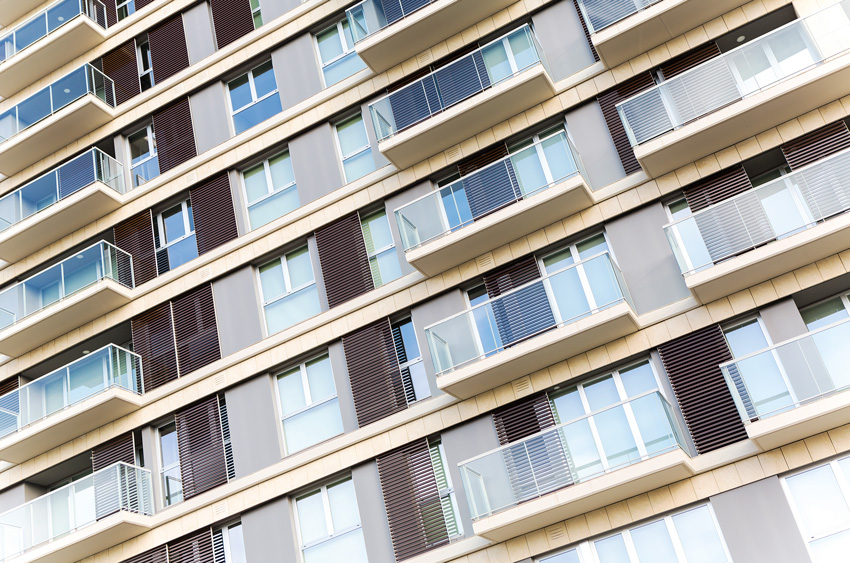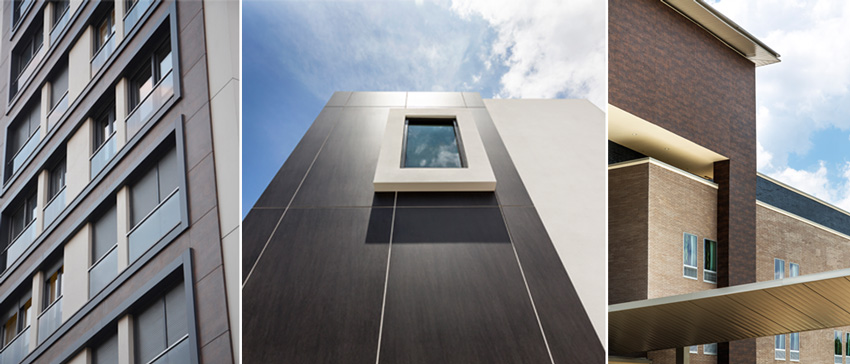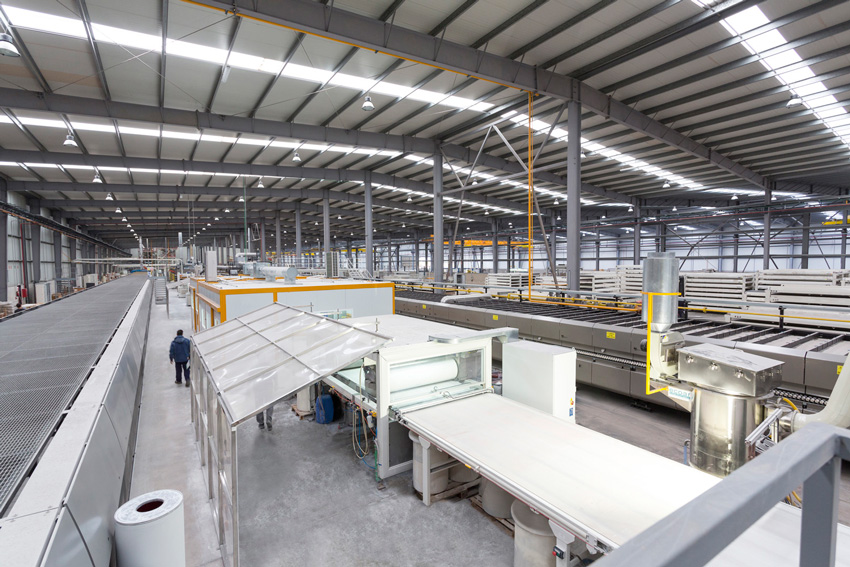Sintered Compact Surfaces For Building Facades
Learning Objectives:
- Identify the characteristics and benefit cial properties of sintered compact surfaces.
- Discuss the manufacturing process of sintered compact surfaces and the suitability of the product to both interior and exterior building applications.
- Assess the functional contributions of sintered compact surfaces as they contribute to green and sustainable building design.
- Specify sintered compact surfaces in a variety of green and conventional buildings, and formulate appropriate selections related to specific applications.
Credits:
Materials used on building facades need to withstand many things, including water, wind, sunlight, and sometimes severe weather conditions. They also need to hold up to the effects of people who may inadvertently or even intentionally cause damage. Choosing a material to use for a facade is certainly influenced by the ability to hold up over time under all of these conditions. It is also influenced by the available size and weight, not to mention the appearance, of the material. Being able to install it in a manner that is efficient and cost effective usually rounds out the criteria for selecting a building material for building facades. Not surprisingly, there are number of different materials that have been available to select from, some of which have been around a long time, and others that are relatively new. There is one new product category that will be the focus of this course, namely sintered compact surfaces, which have been born in the last decade. As it is becoming better known, it is becoming more popular in the United States and Canada thanks to its ability to provide superior long-term performance for basically the same cost as other common facade cladding products. Sintered compact surfaces today are finding their way into curtain walls, rainscreens, siding applications, and other common wall systems for both residential and commercial buildings.

All images courtesy of Neolith by TheSize Surfaces SL
Building facades need to provide aesthetic benefits as well as stand up to a host of environmental and human factors over time. Sintered compact surface facades can meet all of those demands economically.
SINTERED COMPACT SURFACES OVERVIEW
While sintered building facade products may be new, the process of sintering is not. Sintering is a method for creating objects from powders, including mineral, metal, and ceramic powders. As such, sintering has been traditionally used for manufacturing ceramic objects, but there are common applications found across many industrial fields. The study of sintering and of powder-related processes is known as powder metallurgy and is fairly well-known. It is basically the process of using natural materials in powder form and processing them, usually under heat, pressure, or both, to create a desired product.
Looking more closely, sintering is based on atomic diffusion of particles, which occurs most quickly at higher temperatures. The atoms in powder particles diffuse across the boundaries of the particles, fusing them together and creating one solid piece. A simple observable example of sintering can be seen when ice cubes in a glass of water adhere to each other. The edges of the ice cubes, although not powder, can become irregular in the relatively warmer water surrounding it. The water atoms in each of the adjacent ice cubes react and bond together, even though they were originally separate.
Applying this sintering process to manufactured compact surfaces produces a thin, lightweight, and very strong material with properties similar to porcelain ceramic tile. The difference is that sintered products are made from selected natural minerals, with minimal amounts of water. This combination of powdered minerals, referred to as the compact, densifies first under pressure and then becomes nonporous during firing at temperatures below the melting point of the minerals. The powder particles thus bond together due to the applied pressure and heat, which force all surfaces of the particles to be directly connected to all of the surfaces of the adjacent particles, creating a very dense and strong end result.
As a building material, sintered compact surfaces provide a high-performance product with superior physical properties that can realistically be described as ageless in exposed outdoor applications, such as building facades. The material has a naturally high heat and fire resistance due to its all mineral composition. As a dense material, it is scratch and abrasion resistant and quite capable of withstanding even extreme abuse. The density means it is also very resistant to normal freeze-thaw temperature cycles. The material is even resistant to the ultraviolet (UV) rays of the sun, meaning the color and integrity of the surface will not degrade by being exposed to intense sunlight. And with a common porosity of less than 0.08 percent, it is virtually waterproof, meaning no extra sealers are required on the outside surface.

Sintered compact surfaces used on facades are available in a variety of colors, patterns, textures, and appearances.
From a building design standpoint, the surface of the material can provide the look of stone, tile, wood, smooth, or textured surfaces in a variety of colors and hues. However, it is lighter than many of the materials it can look like, weighing in at only 1.1 pounds per square foot for a 1/8-inch-thick panel. For those who maintain the building, they find the dense, nonporous surface easy to clean, including the removal of graffiti so the appearance and color are maintained over time. Even harsh chemicals aren’t a problem to use since it is chemical resistant. All of these design attributes have helped to promote its use not only on exterior walls, but also in interiors for floor and wall surfaces. The material has even been shown to be hygienic and suitable for food contact, which has also led to its use for countertops and food-handling surfaces.
With all of these high-performance and desirable characteristics, it is easy to have the misconception that using sintered compact surfaces for a building exterior is expensive. In fact, it is not. It has been proven repeatedly as being very cost neutral when looking at first costs and comparing it to many commodity facade products, such as aluminum composite paneling. When considering it over the life of the building and factoring in its anti-graffiti, impact resistant, and weather resistant agelessness, it readily lends itself to being an everyday common-sense solution for many architects and designers. Building owners are even quick to see its long-term cost-saving benefits when they realize that it is completely vandalism proof (scratch, paint/ink, impact) and virtually maintenance free for the life of the building.
MANUFACTURING PROCESS
Whether used for interior or exterior final applications, the manufacturing process to create sintered compact surfaces is the same.
Raw materials
Sintered compact surface materials typically require a combination of different materials mined from different locations. The specific materials are selected based on their ability to provide certain desired characteristics. Sand materials, such as silica, quartz, and feldspars, are used to provide hardness, strength, and chemical stability. In addition, some clay is used to provide elastic properties useful during manufacturing and finishing. To create different colors or chromatic properties in the final product, natural mineral pigments of different types can be used. Once all of these ingredients are located and mined, they are transported to the manufacturing facility, where they are stored until ready for processing. Since these are all natural materials, they can contribute to a green and sustainable design in the context of environmentally responsible mining practices.
Manufacturing Process
With the raw materials ready at the manufacturing plant, the first step is to prepare them into a spray dried mixture of sands, clays, and pigment. The mixture is then pressed to form an unfired slab ready to be decorated or colored to suit specific design requirements. The unfired slab needs to have a specific but limited amount of water in order to be pressed. The pressing process can require up to 15,000 psi to properly densify the slab.

Sintered compact surfaces are manufactured from natural minerals and processed in plants using pressure and heat to create the atomic bond between particles.
Once a compact is ready, it can be fired in a large kiln at temperatures below the melting point of the minerals at normal atmospheric pressure. Due to vitrification, some limited shrinkage may occur in the slab during the firing process. This is the point where the sintering takes place, allowing the material to densify and become nonporous. Note that there is no extrusion involved as is common in other materials. Instead, the pressing plus the heat in a kiln produce strong, thin sheets in thickness on the order of 1⁄8 inch, ¼ inch, or ½ inch when finished. The thickness plus the overall face size of the sheets, or panels, can vary by manufacturer, particularly since many provide metric sizes due to their location in countries that rely on metric measurements. At least one manufacturer, however, offers non-metric sizes in 4-foot-by-12-foot and 5-foot-by-10-foot panels to match American construction sizes.









